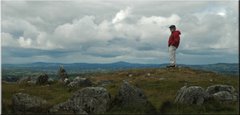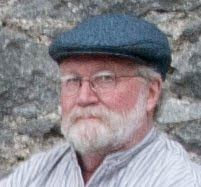Day 22 of 35: Wednesday, August 25, 2010
This day we spent altogether in the Muckross House and Gardens area of Killarney National Park doing things that tourists do in Killarney. We found what we expected: those things have become typical "tourist things" because they are delightful, and because the people of Killarney have honed their craft of tourism for two centuries very well.
First, we took a horse and trap ("jaunting car") ride around the grounds and gardens of the grand house, getting a feel for the place to help us decide what to do with the bulk of the day.
There are horse carts all over Killarney, acting as taxis of a sort for tourists. At the advice of our hotel desk clerk, we drove our horseless carriage to a gathering area across the road from an entrance to the Muckross House and Gardens to hire a ride around the grounds. Our driver’s name Arlen; the horse was Pearl. We were very lucky, it turned out, with our random draw.

Arlen appeared to be the oldest of the many drivers on the grounds that day (and old Pearl, at 17, was probably the oldest horse.) Arlen proved to be able to “read” his clients very quickly, and drove us much more slowly than any of the others, who seemed as intent on making the ride itself exciting for their riders. Arlen stopped and dwelled often on details along the way: subtle clues in the terrain that showed where water might be welled easily, explaining why the ancient abbey was built where it was, for example, and botanical oddities. Much of what he told us might actually have been true. This is exactly the kind of thing that Diane and I love to hear and see, of course, and Arlen picked up on that almost immediately. He was also the only driver we saw who stopped along the way to take photos like the one at above-right. (He handled the bulky Nikon very well.)
Our horsedrawn wander around the grounds took, I estimate, twice as long as others on the same circuit – we were always being passed by faster carts – and that, it turns out, probably cost Arlen money. The Irish government regulates the horse-and-trap operators very stringently on all things from care of the animals to prices they can charge for certain services (like our tour of the grounds.) Since our price was based on the trip itself, not on how much time it took, it’s easy to see why the other drivers were considerably faster. At the end of our ride we included a substantial tip in payment, but maybe not enough (thinking about it later) to compensate for Arlen’s potential reduction in day’s income by catering so well to our preferences.
After our amble around the grounds, we walked around the Muckross Traditional Farms area, where working examples of “traditional” (i.e. up to the advent of electricity and internal combustion farm machinery in about 1925 or so) Irish farming are kept going by the Office of Public Works (OPW).

The buildings and equipment reminded us a bit of the Farmers’ Museum in Cooperstown, New York, but the fact that these were working farms added a great deal – especially (for us, anyway) animals of all sorts from barn cats through draft horses. (Diane made lots of four-footed friends, including a young Irish Wolfhound.)

We finished our tourists’ day with a tour of Muckross House itself (during which no photography is allowed). We felt a happy connection to the grand old mansion because of something we first learned from Arlen that morning and which was mentioned repeatedly during the tour itself: the last people to live in the house were Maud and Arthur Vincent, daughter and son-in-law of William Bowers-Bourne. Bowers-Bourne was the California mining tycoon who built the Filoli estate in Woodside, California, whose house and grounds we have visited often over the years. He purchased the financially-distressed Muckross estate the second decade of the 20th century for his daughter and her Irish husband as a wedding gift.
The ultimate cause of the financial distress of the original owners was none other than Queen Victoria, whose two-night visit here in 1861 required six years of remodeling and renovation which proved more expensive than the family could recover from. Such remodeling is typical preparation for a visit by the royal family – even our hosts, Lord and Lady Rosse, had to do some heavy-duty renovations to Birr Castle when Princess Margaret visited in 1960 with her husband – and her husband was Lord Snowdon, Lord Rosse’s older half-brother, who had grown up in the place.
==================================
More images from this day can be seen in this slideshow over on sharrington.net.
==================================
More images from this day can be seen in this slideshow over on sharrington.net.
==================================
Next: August 26, 2010 -- Brian Boru's Revenge
Previous: August 24, 2010 -- The Beara Peninsula
Beginning of the series: Prologue, August 2
Previous: August 24, 2010 -- The Beara Peninsula
Beginning of the series: Prologue, August 2







4 comments:
If Muckross House doesn't have a Batcave beneath it, it should.
I'm pretty sure that if I had British Royalty visit, my expenses might extend to buying new bath towels at Target. 'Ere's your washcloth, yer Highness, loo's at the top o' the stairs."
Great series. I've got a neighbor with three grown children, two of whom are living long-term in Ireland. My neighbors go over often, love it, and I wouldn't be surprised if someday they move there. Also wouldn't be surprised if you joined them. Writing big books about eccentric earls and giant telescopes takes time....
That's just one of many reasons, Brian, why neither you nor I will ever host British Royalty. But I'm sure it's the main one.
"Eccentric earls and giant telescopes" kind of cries out for a steampunk treatment, doesn't it? I'll try to avoid that.
By the way, don't even think of using "Mystery Project Z." I've already taken it.
One more thing, Brian: where in Ireland do your neighbors' children live?
Both kids are in Dublin. One's married to a native, the other's finishing grad school. My neighbors have done a lot of touring and gotten to know the in-laws in outlying areas. They love it.
Post a Comment